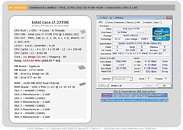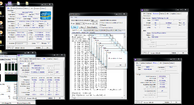- Joined
- Oct 9, 2007
- Messages
- 47,498 (7.49/day)
- Location
- Hyderabad, India
| System Name | RBMK-1000 |
|---|---|
| Processor | AMD Ryzen 7 5700G |
| Motherboard | ASUS ROG Strix B450-E Gaming |
| Cooling | DeepCool Gammax L240 V2 |
| Memory | 2x 8GB G.Skill Sniper X |
| Video Card(s) | Palit GeForce RTX 2080 SUPER GameRock |
| Storage | Western Digital Black NVMe 512GB |
| Display(s) | BenQ 1440p 60 Hz 27-inch |
| Case | Corsair Carbide 100R |
| Audio Device(s) | ASUS SupremeFX S1220A |
| Power Supply | Cooler Master MWE Gold 650W |
| Mouse | ASUS ROG Strix Impact |
| Keyboard | Gamdias Hermes E2 |
| Software | Windows 11 Pro |
Armed with an Intel Core i7-3770K "Ivy Bridge" processor, a G.Skill-made memory kit, and GIGABYTE Z77X-UD5H, proverclocker Sin0822 managed to run a test bench with all four of the motherboard's DDR3 DIMM slots populated, at a DRAM clock speed of 3003 MHz DDR (1501.5 MHz actual). At this clock speed, the test bench was just about stable for its CPU-Z Validation. Sin0822 took advantage of the 29.33 divider for memory, which is exclusive for Ivy Bridge, that Sandy Bridge lacked. The remainder of the clock speed target was met by a gentle bump in the base clock, to 102.37 MHz (from 100 MHz). To achieve a more stable setting in which stress tests can be run, the memory clock had to fall back to 1416 MHz. What makes this feat impressive is the fact that all four DIMM slots were populated.


View at TechPowerUp Main Site


View at TechPowerUp Main Site








 (please watch the entire video clip)
(please watch the entire video clip)